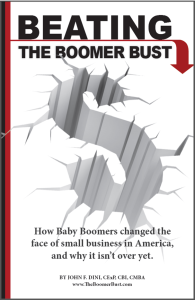For almost ten years I’ve been writing and speaking about the issues facing Baby Boomer business owners as they begin a flood of small business sales. This recent article was syndicated in 16 trade and professional magazines. I reprint it here so readers of “Awake” can share it with their over-50 owner colleagues.
More than 50% of US business owners are over 50 years old, and many of them are looking toward retirement and the process of attracting and vetting potential buyers to take the reins. The differences in yesterday’s and today’s business landscapes are stark—as Boomers were raised in a highly competitive environment, many face the problem of having built companies that won’t attract a new generation of buyers. Three major trends impact the salability of a business. Understanding these trends can help owners transition successfully in a challenging market, and ultimately identify the buyer who will carry their company’s torch going forward.
Why Do Boomers Work So Hard?
Baby Boomers are 2 ½ times more likely to own a business than the generations before or following. Between 1975 (when the first Boomers turned 30), and 1986 the formation of new businesses in America jumped from 300,000 to 700,000 annually. Faced with fierce competition on the pathway to success, many Boomers chose to chase the brass ring by going into business for themselves. New business start-ups have never again reached that level. The result is that nearly two-thirds of all businesses with fewer than 500 employees are in the hands of people who are preparing to retire.
The impact of the Baby Boomers at each stage of life created a one-time surge in many statistics. They tripled the number of college graduates, and brought over 50 million women into the workforce. Between 1970 and 1980 the population of the United States increased by 11%, but the employment base grew by an astonishing 29%. Replacing such a massive segment of the population in the business sector is no easy feat.
The Perfect Storm
 There are three major trends that challenge a small business owner preparing to exit. Like the movie “The Perfect Storm,” these three trends; demographic, psychographic and sociographic, are combining to create a Tsunami that will change the entire landscape of independent business ownership.
There are three major trends that challenge a small business owner preparing to exit. Like the movie “The Perfect Storm,” these three trends; demographic, psychographic and sociographic, are combining to create a Tsunami that will change the entire landscape of independent business ownership.
- Demographically, the generation following the Boomers (Gen X) is much smaller. From a supply and demand perspective, there simply aren’t as many available buyers as the number of potential retirees seeking them.
- The psychographic profile of the buyer generation is unfavorable. What business owner hasn’t complained about the work ethic of the younger generation? Raised in a forty year period of economic growth (the longest sustained period of expansion in our history) Generation X and their successors (The Millennials) are more likely to choose family first, and perceive jobs and employers as merely the means to a personal end. They aren’t wrong. The parents of the Boomers’ understood the difference between work and personal life. One started when the other ended. In their drive for success, the Baby Boomers mixed the two and created the term “work/life balance”. Younger generations are actually returning to an older set of values.
- Sociographic trends favor alternative careers over business ownership. Corporate America is well aware of the issues and attitudes of the younger generations. They have already made many adjustments. Telecommuting, sabbaticals, family leave, and flex time are benefits designed to attract younger workers who have a different set of priorities. Few small businesses have the depth or breadth to allow skilled employees to come and go according to their individual priorities.
Young entrepreneurs have little interest in the service-oriented brick-and-mortar companies that dominate small business. They seek a level of freedom that doesn’t require being on call, schedules driven by customer convenience, or a 55 hour work week. Combined with the sheer lack of prospective buyers, a reduction in the number of small businesses becomes more than likely, it is inevitable.
Yet, many small business owners are depending on their company to fund a comfortable retirement. Their plan goes something like this: “I will work really hard until I am tired, and then I will find some energetic younger person just like me who is willing to commit everything for this great opportunity.”
Beating the Odds
Fortunately, if you are a successful business owner, you’ve already proven your competitive instincts and abilities. With some planning and foresight, you can still beat the Boomer Bust and achieve your retirement objectives. There are two pathways to succeeding in a crowded sales marketplace.
Build to Sell
Your first option is to build a business that is attractive to your younger buyers. It allows for personal flexibility. It can’t require a huge down payment, since these generations were raised in a “buy-now-pay-later” world, where they are carrying substantial debt from the day they graduate college, and have little opportunity to amass liquidity.
Your technology doesn’t have to be cutting edge, but it needs to be current. Nothing turns off the tech-savvy young buyer faster than a company that is limping along on outdated software or (heaven forbid) paper. Of course, the other attributes of an attractive acquisition; growing margins, a distributed customer base and predictable revenues, are a given.
Hire Your Buyer
The second option is to hire your buyer. The stereotypes of different generations aren’t universal. Certainly we all know Boomer slackers, as well as young people who are ambitious and hard-working. Lacking capital, many of those younger go-getters would like to own a business but have difficulty seeing how they can make it possible. Identifying such a buyer in your own organization, or even reaching outside and recruiting one, is a viable option if your target date for exiting is a few years away.
Creating your own successor requires a commitment to planning and development, but the financial aspects are fairly simple. A few years of selling equity in small amounts can let your successor build a minority stake. Then he or she can obtain third-party financing for the balance of the purchase so you can maintain control through the process, and take the proceeds with you when you leave.
Remember; “The more you work in your business, the less it is worth.” Everything you do to reduce your business’s dependence on your personal talents, to reduce the time commitment of running it, and to make it easier for any successor (whether internal or external) to take over the reins, also increases its value to any buyer.
You can’t change the factors that create the most competitive selling environment in history. Understanding what the future looks like, and realizing that your buyer is unlikely to be someone “just like me” is a critical first step in the process.
My 48 page Ebook Beating the Boomer Bust is available as a free download in either printable or E-reader formats here.
 When you are starting out, have fewer people depending on you, and mistakes have fewer consequences (see my 2014 post The Luxury of No Resources), it’s easier to take a leap. If you fail, you’re not much worse off than you were before. But there are costs to learning by trial and error. After a while, going back to the drawing board becomes tiresome.
When you are starting out, have fewer people depending on you, and mistakes have fewer consequences (see my 2014 post The Luxury of No Resources), it’s easier to take a leap. If you fail, you’re not much worse off than you were before. But there are costs to learning by trial and error. After a while, going back to the drawing board becomes tiresome.



